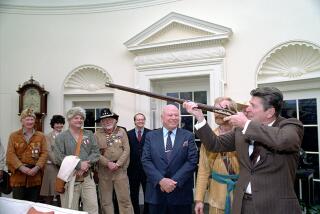Forget Handouts; Spur Production
- Share via
With the hodgepodge of programs proposed to alleviate the current recession, it is worthwhile to look back to the time in U.S. history when the federal government first stepped in with massive stimulus programs: the New Deal.
President Roosevelt’s 1930s programs consisted of five major categories: large-scale civil infrastructure such as the Hoover Dam, interstate road construction and water and sewer works; programs that provided direct relief for people and make-work or small-scale jobs such as building sidewalks or post offices; subsidies to farmers; loans to state and local governments, homeowners, bankers and industries; and the insurance of mortgages and home improvement loans by the Federal Housing Administration.
Inside the Roosevelt administration, there was a deep philosophical division. Public Works Administration head Harold Ickes fought for careful planning of large-scale projects that would have lasting effects on the economy, even if it meant delays in the distribution of funds. Harry Hopkins, the administrator of the major relief programs, argued for distributing money to the unemployed quickly, with fewer worries about the long-term value of the projects.
Our research suggests that Ickes’ was the better approach. An additional dollar spent on building large-scale infrastructure projects raised income by approximately $2. These projects not only provided jobs for the unemployed but also raised the productivity of the private sector and of state and local governments.
The relief programs had much smaller effects on the economy. Certainly, the people getting direct help benefited, but the nature of the projects appear not to have led to the kind of spillovers that stimulated productivity in the private sector. Further, the huge infusion of federal funds allowed state and local governments to spend less.
Federal spending on New Deal agricultural programs, which paid farmers to remove land from production, had the unintended consequence of diminishing consumer spending. The reduction in cultivation meant farms needed less labor. The payments also encouraged farmers to mechanize and to use their available land more productively, which further lowered the demand for labor. Thus, unemployment and lower incomes among farm laborers--and less spending.
The New Dealers also experimented with a wide range of loan programs, but these had little effect on the depressed economy. While the loans provided an immediate infusion of cash, state and local governments raised taxes or collected reserves in anticipation of retiring the debt.
But the mortgage insurance program had a significant effect on the economy. The FHA insured loans for home repairs and mortgages for both new and existing homes, which helped stimulate the construction industry. For each additional dollar of mortgage and home improvement loans insured by the FHA in an area, retail sales grew by about 90 cents. The program introduced a structural change in mortgage lending by lengthening loan amortizations and altering terms of down payments. Monthly payments dropped, leaving homeowners with more money to spend.
What lessons can be learned from the New Deal?
Simply showering money on the economy is not enough.
The spending programs that stimulated the economy most during the 1930s succeeded because they raised the productivity of the economy generally, not simply benefiting those directly employed on the projects.
As the president and Congress debate an economic stimulus package, they should not expect dramatic results unless they take care to cull the wheat of long-term productivity effects from the chaff of simple handouts.
More to Read
Get the L.A. Times Politics newsletter
Deeply reported insights into legislation, politics and policy from Sacramento, Washington and beyond. In your inbox three times per week.
You may occasionally receive promotional content from the Los Angeles Times.










